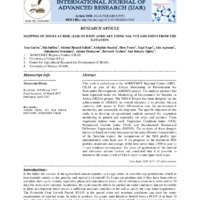Recherche
2 items
Mapping of Zones At Risk (ZAR) in west Africa by using NGI, VCI and SNDVI from the E-statuib
This work is carried out at the AGRHYMET Regional Centre (ARC)-CILSS as part of the African Monitoring of Environment for Sustainable Development (AMESD) project. The analysis protocol has been improved under the Monitoring of Environment for Security in Africa (MESA) project. The MESA Project has been designed on the achievements of AMESD; its overall objective is to provide African countries with access to Earth Observation data for environmental monitoring and sustainable development. The specific objective of this study is to develop an operational analysis protocol for vegetation monitoring in general and especially for crops and pastures. Three vegetation indices were used: Vegetation Condition Index (VCI), Normalized Growth Index (NGI) and Standardized Normalized Difference Vegetation Index (SNDVI). The analysis of these drought indices is based on taking into account the agro-climatic characteristics of the Sahelian region, the comparison of the NGI profile (per administrative unit) from year X (in progress) to the maximum NGI profiles, minimum and average of the time series data (1998 to year x-1) and evidence convergence. Six years of application of the method and validation actions carried out concluded that it is possible to determine the zones at risk (ZAR) in order to anticipate food crises.
VALIDATION OF A HERBACEOUS BIOMASS ASSESSMENT MODEL FOR SAHELIAN RANGELANDS (BIOMASAH) IN NIGER
This study was carried out in the pastoral zone of Niger with the aim of validating outputs of the BIOMASAH model developed by the AGRHYMET Regional Centre (ARC) relative to real data collected over the 2001-2011 period by the Ministry Livestock and Animal Industries (MEIA) of Niger. We used parametric tests (t-tests) and nonparametric tests (Wilcoxon and sign tests) for mean comparisons. A correlation analysis was performed by calculating Pearson’s r, Spearman’s ρ, Kendall’s T and Hoeffding’s D correlation coefficients. The results showed that the BIOMASAH model generally overestimated biomass (983.17 vs. 591.17 kg/ha) with a highly significant difference relative to the field findings (P <.0001). Pearson’s r (0.15), Spearman’sρ (0.22) Kendall’s T (0.13) and Hoeffding’s D (0.1) correlation coefficients were low but highly significant (p <.0001). Grazing pressure and spatiotemporal variability of rainfall helped explain the noted differences.

